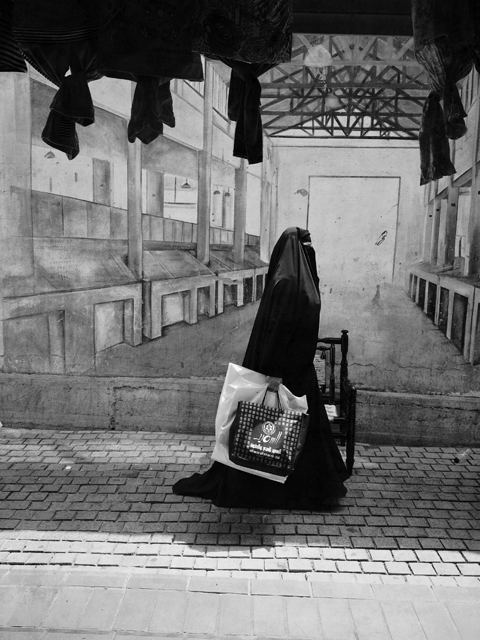 Photo taken by Khaled Al-Abdul Mughni at Souq Al Mubarakiya.
Photo taken by Khaled Al-Abdul Mughni at Souq Al Mubarakiya.The scene is quiet. A tall Kuwaiti man crosses his hands, a Leica camera hanging from a strap from his shoulder to the side of his waist. He's chatting with the man behind the counter, an older Arab date vendor, about the future of Souq Mubarakiya. The former is Khaled Al-Abdul Mughni, a prominent Kuwaiti street photographer and a businessman who, on that morning, was turning his lens to the troubles and delights found in one of Kuwait's oldest markets.
Abdul Mughni works to capture the everyday life of Kuwait, the good and the bad, the beautiful and the grotesque. He's not often rewarded for his efforts. In fact, many in Kuwait prefer stylized, heavily-edited photos where only the best and most beautiful aspects of the country are showcased rather than anything that might be deemed negative.
"I was shooting everything, movement of people and light and shadow reflections on things around me. Then I realized the importance of showing the identity of the place. After seven years of practice, I discovered that I'm finding myself more in human dimensions," Abdul Mughni told Kuwait Times.
Because of Executive Director Sami Al-Ramyan's collaborative work with media specialists for documentary film production, he realized early the importance of this medium. "I read a lot about street photography and documentaries. Also, the iPhone made me practice on a daily basis in the streets in the beginning together with my camera," he said.
Challenges
According to Ramyan, there are a lot of challenges facing street photographers in Kuwait. "One day, I went with my sister Huda, who's also a street photographer, to shoot one of the places, where she was very welcomed and the people were very enthusiastic to help with her project. However, I wasn't accepted because of my gender. They trusted her because she's a woman, but they doubted my intentions and started questioning me whether I was going to take their pictures and publish them on the Internet without their permission, like I was assaulting their honor," he recalled.
Street photographers also have to overcome many hurdles in order to give an objective picture of life in this country. One major problem is the visual pollution caused by the arbitrarily designed architecture. They also have to deal with Kuwaitis' similar outer appearances, which results in monotonous or superficial images. Comparatively, it's easier to photograph expats than take pictures of Kuwaitis. Not to mention that photographers are exposing themselves to legal accountability if they photograph people without their consent or knowledge. Candid photography is limited by law within public events, but people in Kuwait are conscious of being photographed and like to be seen as a conservative society.
Impenetrable facades
In the nineteenth century, British explorer William Shakespeare documented street life in Kuwait during the reign of Sheikh Mubarak Al-Sabah. Abdul Mughni explains why people didn't reject his photography - because at that time they did not see the prints and their impact. "They may not even know what a camera was!" he added.
Now photographers in Kuwait are in constant conflict with the contradictions of its people. Some of them pose for street photographers they encounter outside Kuwait, while behaving the opposite here. Moreover, many of them openly share pictures of their private lives on social media, but they refuse to be a subject of a documentary project within the walls of their homes.
If they do agree, some women cover their hair or faces. They also wear clothes that are usually not worn at home, and even use household utensils that are only for guests. They show the best possible image of them because they are driven by a society that stresses on idealism and conservatism.
"The only way to break this barrier is working within the frame of professional ethics, making well-structured projects and having clear objectives. Certainly, with determination not to give in, the photographer will get what he wants in the end," Ramyan told Kuwait Times.
"These projects should be about stories of life in all its forms - things that need to be appreciated and the things that need to be changed. This type of photography is not for amateurs only, but even the press, because it's the core of photojournalism. I do not see interest by Kuwaiti newspapers to document everyday lives - as far as I know, Kuwait Times is the first and only paper to do this," he declared.
Why is it Important to Kuwait?
There is a broad difference between street photography, travel photography and event photography. "Photos of citizens expressing delight during the national celebrations are real, but they don't probe the depths of society," Abdul Mughni explained.
The scarcity of documentary archives of our social life emphasizes the wrong stereotype about people of Kuwait. We are in 2016 and there are still many people around the world who believe that there is oil gushing from every house yard of Kuwait. If one is asked about Kuwait, his answer would probably be Saddam Hussein and the Gulf War.
The breach in the balance of depicting the positive and negative aspects leads to create a perverted image of Kuwait. Every picture of this society is a part of a larger media puzzle we pass on to future generations. What do you want your grandchildren to know about Kuwait? How do you want the world to see it now? Let's photograph the present through our parent's eyes, disregarding what we would like to fix and not ignoring the success stories of community members of different statuses.
By Athoob Al-Shuaibi










